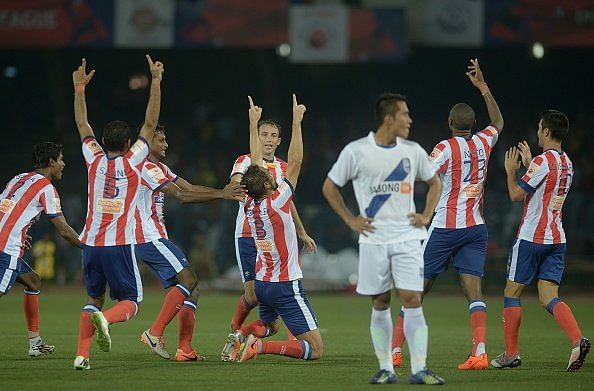
ISL Match 1: Atletico de Kolkata 3 Mumbai City FC 0 - Tactical analysis
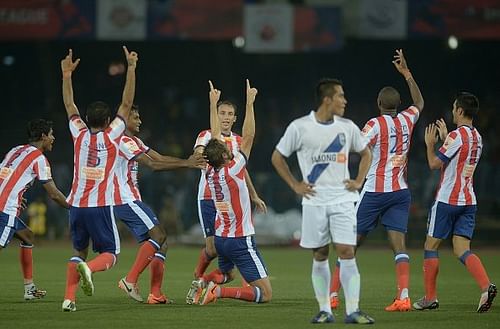
The Indian Super League’s much awaited opening lived up to its expectations with a glamorous ceremony which had its fair share of Bollywood stars, cricketing legends and politicos. But eventually in a football tournament, it is the football that does all the talking.
The inaugural match between the home side Atletico de Madrid and Mumbai City FC started off as a scrappy affair but eventually came into its own. Luis Garcia and company showed their clear superiority over the course of the 90 minutes and scored three very different and spectacular goals to set the ball rolling in this ambitious football project. We look at the tactical and technical aspects of the match:
Formations
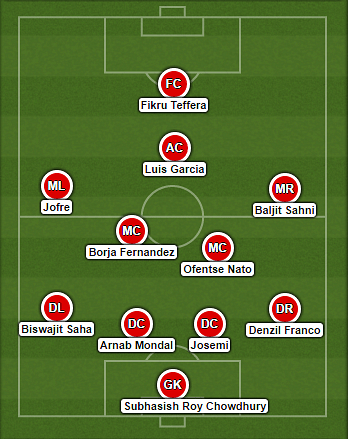
Both managers opted to play with what looked like a 4-4-1-1 formation, with an advanced playmaker playing off the lone striker. With some players flying into India only recently and some important players missing, both Antonio Habas and Peter Reid tried out an experimental formation to evaluate their first-choice players and devise a long-term tactical strategy.
Atletico de Kolkata
Luis Garcia, a natural attacking midfielder, played in his favoured No. 10 role, just behind Fikru Teferra. Baljit Sahni was shifted from his natural position of a striker to the right flank. Borja Fernandez, a Real Madrid academy product, played as the more advanced of the two holding midfielders while Arnab Mondal and Josemi started as the two centre halves. Denzil Franco and Biswajit Saha manned the flanks as the right and left full-backs, respectively.
Luis Garcia was a constant menace in the opposition half with his off-the-ball running and trickery while Fikru imposed his physicality on the experienced Friedrich and Cmovs. Most of Atletico’s attacks came from the right flank and they held the ball really well and looked to attack with every possible opportunity. Kolkata had several shots on target and if not for Subrata Pal’s heroics, the margin of victory could have been much bigger.
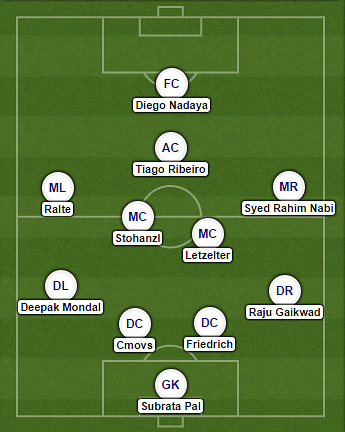
Mumbai City
The most surprising aspect of the Mumbai City line-up was seeing a number of Indian players not being deployed in their natural positions. Deepak Mondal and Raju Gaikwad, both centre backs, started on the flanks while Syed Rahim Nabi was ineffective as a right-sided midfielder.
Blame it on the pitch or the occasion getting to the players, but Peter Reid’s renowned passing game wasn’t on show at the Salt Lake Stadium. Mumbai failed to keep any sort of ball possession, especially in the first half, and were relentlessly stretched in Kolkata’s final third. They lacked incision upfront and sorely missed the creativity and experience of Anelka and Ljungberg.
Although they did manage to create a few good goal-scoring opportunities in the second half, but Mumbai’s attacking players were wasteful and lacked composure. Ralte looked isolated on the left-flank and rarely tracked back to help his left full-back Deepak Mondal.
Pitch
Heading into the tournament, numerous questions had been raised about the artificial turf at the Salt Lake Stadium. Kolkata players had voiced their satisfaction on the state of the pitch and having played a few friendlies in the run up to the tournament, they felt a decent degree of comfort playing on it. For Mumbai City’s foreign contingent, this was supposed to be their first encounter with an artificial football pitch, and it didn’t turn out to be a happy one. The pitch seemed sluggish and had uneven bounce which made ball control dodgy and the surface wasn’t slick enough as compared to its grass counterpart.
The artificial turf made it difficult for Mumbai City to execute their passing game and by the time they came to grips with the pace and bounce of the turf, Atletico de Madrid had already run away with the game. This synthetic turf, the only one in the eight recognised ISL stadiums, will remain a potent weapon at home for Antonio Habas as other teams too are expected to find it difficult to adapt to his surface.
Goals
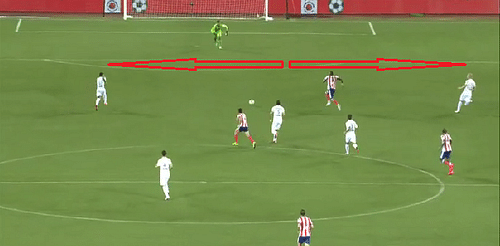
First goal (Fikru Teferra) –The Ethiopian took advantage of shocking defensive positioning of Mumbai’s central defenders. Left-winger Jofre exploited a huge gap between Cmovs and Manuel Friedrich and sent Fikru through on goal, and the Ethiopian, who just had just the goalkeeper to beat, did so with elan by hitting a delightful chip into the back of the net.
Second goal (Borja Fernandez) – A poor defensive clearance by a Mumbai defender near the penalty box gave the possession back to Kolkata and the central midfielder latched onto the ball and let fly an incredible volley into the top right corner. This goal could have easily been avoided had the defender not a made a meal of a simple clearance.
Third goal (Arnal Llibert) – A classic counter-attacking goal in the dying stages of the match when Mumbai City had pushed high up into Kolkata’s half in search of a consolation. The impressive Fikru ran down the right flank unchallenged and found a simple pass for substitute Arnal to smash home. Again, Mumbai’s defensive formation was haywire and totally out of place.
Goalkeeping
The most positive aspect of the inaugural ISL match was the quality of goalkeeping on show. Custodians on both ends of the pitch, Subrata Pal (Mumbai City) and Subhashish Roy Chowdhury (ATK), were splendid in goal and made some breathtaking saves throughout the game.
Pal made a string of saves in the first half, most notably off Baljit Sahni’s one-on-one shot in the opening exchanges followed by Luis Garcia’s instinctive volley a few minutes later. Some pundits might put Pal at fault for the first goal but with Fikru through on goal, he didn’t really have any other option but to charge down and make himself big on the striker.
As Mumbai City stepped up the pressure in the second half, Chowdhury was repeatedly called into action and his one particular save, off a deflected Cmovs long-range effort, was absolutely incredible. Chowdhury’s trademark smile will be remembered as an iconic element of the inaugural match of the Indian Super League.
Conclusion
A game which started off sluggishly, slowly grew into an extremely entertaining encounter with plenty of eventful moments, from crushing tackles, flying saves and spectacular goals.
Atletico showed their immense class and superiority and reinstated the advantages of starting their preparations well before the other clubs. Mumbai dearly missed two of their most important players, Anelka and Ljungberg, and although they did show some grit and fight in the second half, but Peter Reid would be very disappointed with the tactical aspects of his team’s display. For Antonio Habas, it was a fruitful first outing infront of his home supporters and he’d have every reason to be pleased with the way his team have kicked-off their season.
The opening game of the Indian Super League not only stood out for its gala opening ceremony and its band of celebrities but more importantly for its entertaining brand of football. And when you consider that this was just the first competitive game for both teams, the quality of football, the diversity of tactics and the technicality on display is only going to get better.